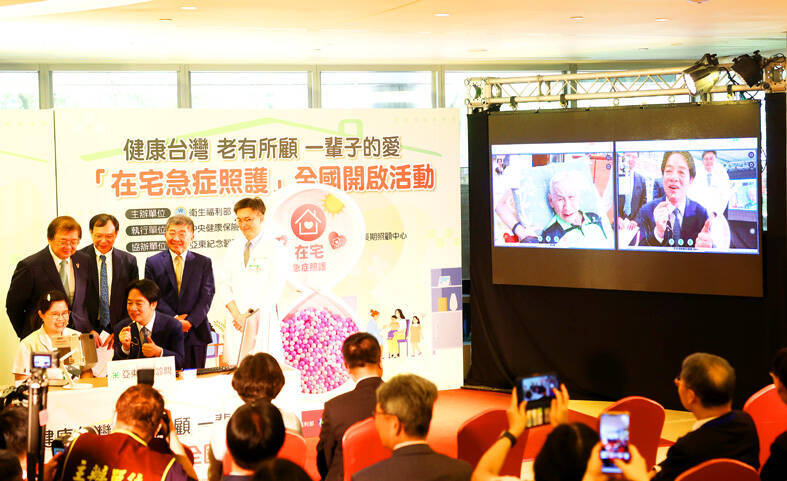《TAIPEI TIMES》President views remote acute care trial launch

President William Lai, seated, second left, speaks to a patient remotely during an inspection of the “acute care at home” trial program at Far Eastern Memorial Hospital in New Taipei City yesterday. Photo: CNA
CLOSE TO HOME: William Lai said that he wants to promote telemedicine because of his experiences as a doctor and growing up in a remote township
By Lee I-chia / Staff reporter
President William Lai (賴清德) yesterday visited a hospital to oversee implementation of the “acute care at home” trial program after amendments to the Rules of Medical Diagnosis and Treatment by Telecommunications (通訊診察治療辦法) aimed at expanding telemedicine services took effect on Monday.
The amendments added five new categories of people eligible for telemedicine: those in a chronic care program, under hospice care, in correctional institutions or under disability care, or those receiving treatment for an illness or injury sustained in a disaster, an infectious disease or for other major incidents.
The pre-existing five categories of eligible people were those receiving post-acute care, long-term care, international medical care or home-based medical care, or people who have been admitted by a family doctor.
In all cases, they must either have received approval from the local health department or be included in the National Health Insurance bundled payment programs.
Lai yesterday visited Far Eastern Memorial Hospital (亞東醫院) in New Taipei City’s Banciao District (板橋) to observe the implementation of the new program.
Minister of Health and Welfare Chiu Tai-yuan (邱泰源) said Taiwan would become a super-aged society next year, meaning people aged 65 or older would account for more than 20 percent of the population.
The acute care at home trial program is expected to alleviate the burden caregivers face of having to take elderly patients to and from hospitals, by linking long-term care resources and bringing medical care to people at their homes or care facilities, Chiu said.
Lai, formerly a physician, said that when he was a resident doctor, some bedridden patients were brought by their family members to see him.
He said he also grew up in a remote township with limited medical resources, where doctors would send people medicine or voluntarily conduct free consultations.
That is why he wants to promote home-based healthcare services, Lai said.
The expansion of telemedicine services and the launch of the trial program can be seen as a milestone for Taiwan’s healthcare services, Lai said.
As technology advances, Taiwan must apply it to healthcare services to benefit the public, he added.
Demonstrating the telemedicine service, a nurse held a teleconsultation with a bedridden patient nicknamed Ah Hua (阿華). Lai stood to the side as a doctor encouraged Ah Hua to sit up and try to walk more often.
The program has teams of doctors, nurses, pharmacists and respiratory therapists providing integrated care to people who need antibiotic treatment for pneumonia, urinary tract infections or soft tissue infections, National Health Insurance Administration Director-General Shih Chung-liang (石崇良) said.
The patients can choose to be hospitalized or to receive home-based care using telemedicine, equipment to remotely monitor their vital signs and bedside testing, which would enable them to rest at home while receiving treatment, he said.
The trial program is expected to benefit about 5,400 people, he added.
新聞來源:TAIPEI TIMES














